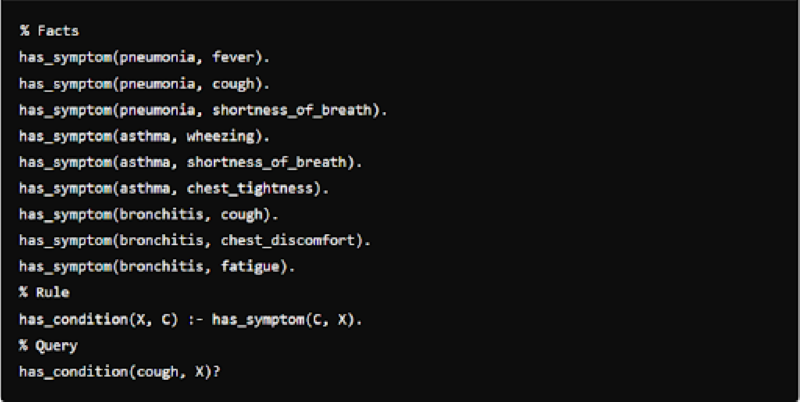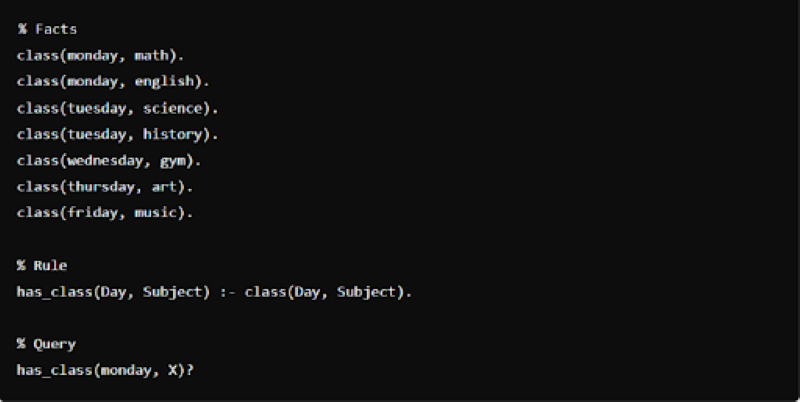A Complete Guide – How to Use the Programming Language Prolog
If you want to improve your skill set by learning a new programming language, say hi to Prolog, your new friend. Prolog has been around since the 1970s and has been a great problem-solving tool, mostly in the AI and Computational Linguistics sectors. Its unique declarative style enables programmers to handle complex problems without writing sophisticated code!
Table of Contents
In this article, we’ll focus on everything you need to know about Prolog. We’ll also look into how to use Prolog to solve real-life problems.
What is Prolog Programming Language?

Prolog is a logical and declarative programming language. The name Prolog stands for PROgramming in LOGic. The language was initially created to help intelligent systems reason and make decisions like humans.
Here’s a general illustration of how Prolog programming works.
Even when the use of Prolog programming has decreased, the tool offers significant help in NLP, automated reasoning, and expert systems.
Understanding Prolog Programming basics

Prolog’s structure is pretty simplified, making it easy to understand, even for beginners. Let’s discuss the components that make up the Prolog programming environment.
The programming language Prolog has three main components: facts, rules, and queries. However, to have a seamless experience, you’ll need to grasp how to use names and symbols in the platform.
Symbols
You’ll interact with these common symbols in a Prolog programming environment.
| Operation | Symbol |
| and | , |
| or | ; |
| if | :- |
| not | not |
Names and Variables
Object names, function names, and predicate names must begin with a lowercase letter. Variables, on the other hand, must start with an uppercase letter or underscore symbol.
Examples of names in Prolog:
- john.
- jane.
- likes.
Examples of variables in Prolog:
- Person.
- X.
- _Y.
Facts
Facts are the basic building blocks of Prolog’s knowledge base. They contain the foundational information that the program uses to make decisions.
A fact declares the relationship between entities within the knowledge base and is defined by a predicate.
ALL facts in Prolog end with a period. Variables in Prolog fact statements quantify the objects in question—for example, likes(X, eric). – Everybody loves Eric.
More examples of facts in Prolog.
| Syntax | Examples |
| relation(term1, term2, …, termN). | friends(john, mary). – John and Mary are friends |
| likes(susie, john). – Susie likes John | |
| not(likes(jane, pizza)). – Jane does not like pizza | |
| likes(peter, cate) ;- likes(cate, peter). – ?Peter likes Cate if Cate likes Peter. |
Rules
Rules define relationships among facts. They are mostly composed of two parts. The first part specifies a predicate, while the last contains one or more conditions that must be satisfied for the rule to be true.
The if (:-) symbol instructs the program to perform a logic operation.
Here’s the basic syntax of rules in Prolog.
defined predicate ;- condition1, condition2. (you can include more than two conditions)
Examples of rules in Prolog
| Syntax | Examples |
| predicate ;- condition1, condition2. | parent(X, Y) ;- sibling(Y, Z). – X is a parent of Y, if Y is a sibling with Z. |
| likes(james, cate) ;- likes(cate, john) – James likes Cate if Cate likes John. |
Queries
Queries are the questions you ask the program when intending to receive output. They are statements that need to be proved true based on the rules defined in Prolog’s knowledge base.
The (? -) symbol is used right at the beginning of every query.
Here are a few examples of queries in Prolog.
| Syntax | Examples |
| ?- predicate(condition1, condition2). | ?- friend(john, mary). – Is John friends with Mary? |
| ?- ancestor(tom, susan). – Is Tom an ancestor of Susan? |
The responses will all be derived from the facts and rules stated in the knowledge base.
Queries are crucial to Prolog programming as they allow you to test hypotheses, retrieve information, and find logical solutions.
When running queries, Prolog might return one or more solutions, depending on what’s in the knowledge base. However, you’ll get a failed query if the program doesn’t find a solution.
Applications of the Programming Language Prolog

Prolog has been used popularly among AI applications due to its unique properties and logical operation.
Here are some of the most popular use cases of the Prolog programming language.
- AI and NLP—Prolog’s ability to handle logical situations allows it to be used in developing human-emulating systems. Its pattern-matching ability is used to create chatbots or text-parsing software.
- Database Systems—Prolog programming can be used to create and implement deductive databases. If you remove lists and complex terms from Prolog programs and disallow recursive definitions, the resultant language is equal to an SQL subset.
- Healthcare and Medical Diagnosis—Prolog can be used in healthcare institutions to help with medical diagnoses. Programmers create knowledge bases and define the facts and rules that will be used to provide logical diagnostic solutions.
- Education—Prolog can be used to create individually tailored tutoring systems. It can also introduce personalized instructions and tests depending on a learner’s progress.
- Internet of Things (IoT) – Prolog’s ability to respond to queries based on fixed instructions makes it viable for various IoT applications. Logical approaches are crucial for operating smart devices and handling dynamic event-driven concepts.
Prolog Programming Examples
Check out the following Prolog programming examples with explanations below;
Example 1 – Medical field

Explanation:
- Pneumonia symptoms are fever, cough, and shortness of breath.
- Asthma symptoms include wheezing, shortness of breath, and chest tightness.
- Bronchitis symptoms are cough, chest discomfort, and fatigue.
The Prolog application helps in medical diagnosis by giving logical solutions based on the patient’s symptoms.
Example 2 – Scheduling application

Explanation:
- The facts show that there’s a class scheduled every day of the week.
- The rule is that we have a class for a certain subject every day.
- The query seeks to find out how many classes are scheduled for Monday.
Prolog programming can help to retrieve someone’s class schedule, helping in timetable generation or general educational planning.
Advantages of Prolog Programming
- Simple declarative approach – Prolog allows you to write complex logic easily through its declarative style. The programming language only focuses on what needs to be solved and doesn’t involve intricate algorithms.
- Logical reasoning – From Prolog’s logic-solving capabilities, it excels in avenues that leverage intelligent problem-solving skills.
- Ease of customization—You can add your own constraints to the Prolog editor to suit your needs. Users also get extensions to help with varying requirements.
- Enables rapid prototyping—Prolog helps professionals test different approaches to finding solutions. Its concise syntax is handy in rapid testing and prototyping.
- It has built-in backtracking capabilities. Prolog’s backtracking capabilities are crucial in expert systems, search algorithms, and constraint satisfaction. Backtracking allows developers to explore numerous solutions to a problem.
Disadvantages of Prolog
The simple design of this language comes with its limitations. Here are the main limitations of using Prolog:
- Limited library resources—Prolog has limited frameworks, tools, and resources, which makes it challenging during integration and in developing certain functions.
- Lack of Standardization—Prolog has different versions, each with unique features and syntax. This creates compatibility problems when working from different Prolog environments.
- Prolog is not suitable for all problems. Even when Prolog is powerful enough to handle some tasks, you might rely on something other than it for other applications. Areas requiring complex algorithms and intricate real-time control are better handled with different languages.
FAQs About Prolog Programming Language
Here are the questions that most people ask concerning Python programming.
What Algorithm Does Prolog Use?
SLD resolution. Prolog also employs a first-order logic subset, the horn logic, in operations.
Does Prolog Use Data Types?
Prolog has one datatype, with numerous subtypes; numbers, names, variables, and atoms.
Key Takeaways
Prolog is an example of fourth-generation programming. It is declarative and solves logical problems. The fundamental components of prolog programming are:
- Rules.
- Facts.
- Variables.
- Queries.
All information is stored in a knowledge base.
Due to its simple design, this programming language Prolog has been used by industries to solve numerous situations. Industries actively using AI or performing symbolic reasoning tasks can incorporate Prolog to smoothen automation and logical operations. If you’re interested in efficiently collecting large amounts of data, consider utilizing web scraping tools like Scraping Robot. Sign up today to learn more and get 5,000 free
The information contained within this article, including information posted by official staff, guest-submitted material, message board postings, or other third-party material is presented solely for the purposes of education and furtherance of the knowledge of the reader. All trademarks used in this publication are hereby acknowledged as the property of their respective owners.
